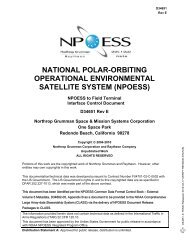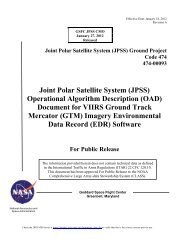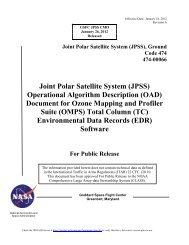VIIRS Suspended Matter ATBD - Nasa
VIIRS Suspended Matter ATBD - Nasa
VIIRS Suspended Matter ATBD - Nasa
Create successful ePaper yourself
Turn your PDF publications into a flip-book with our unique Google optimized e-Paper software.
D43315_D<br />
Page 8<br />
where V is the visibility in kilometers and C is the smoke concentration in g/m 3 . This<br />
approximate expression is accurate to about 50% and needs to be refined. The visibility is<br />
horizontal visibility and <strong>VIIRS</strong> is responding to vertical visibility, so there probably will be no<br />
one expression that is always applicable due to the complex structure associated with smoke<br />
plumes.<br />
Visibility can also be related to aerosol optical thickness. From Iqbal (1983) the relationship for<br />
low visibilities can be written as:<br />
V = 3.9449 / (/0.55 - 0.08498) (2)<br />
where and are the Angstrom coefficients, V is the visibility in kilometers, and 0.55 is the<br />
wavelength at which visibility is measured, namely 0.55 microns (or 550nm).<br />
The previous expression can be written in terms of the aerosol optical thickness at 550 nm (550)<br />
as follows:<br />
V = 3.9449 / (550 – 0.08498) (3)<br />
The first and third equations above can be combined to give the smoke concentration C as<br />
follows:<br />
C = 253.5 550 –21.5 (4)<br />
A plot of this relationship is shown in Figure 10:<br />
Smoke Concentration (ug/m^3)<br />
1800<br />
1600<br />
1400<br />
1200<br />
1000<br />
800<br />
600<br />
400<br />
200<br />
Smoke Concentration vs AOT at 550 nm<br />
0<br />
0.0 1.0 2.0 3.0 4.0 5.0 6.0 7.0<br />
AOT at 550 nm<br />
Figure 2. Smoke concentration (g/m 3 ) vs aerosol optical thickness at 550 nm.






